24.01.2018
Next Mars Lander Spreads Its Solar Wings
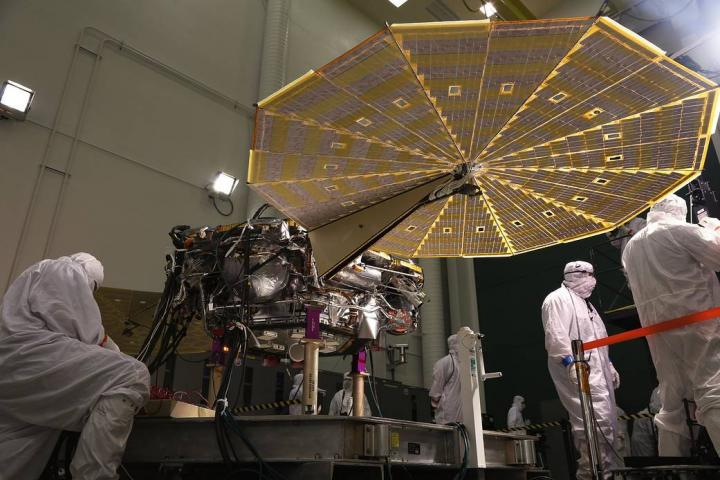
While in the landed configuration for the last time before arriving on Mars, NASA's InSight lander was commanded to deploy its solar arrays to test and verify the exact process that it will use on the surface of the Red Planet. During the test on Jan. 23, 2018, from the Lockheed Martin clean room in Littleton, Colorado, engineers and technicians evaluated that the solar arrays fully deployed and conducted an illumination test to confirm that the solar cells were collecting power. The fan-like solar panels are specially designed for Mars' weak sunlight, caused by the planet's distance from the Sun and its dusty, thin atmosphere. The panels will power InSight for at least one Martian year (two Earth years) for the first mission dedicated to studying Mars' deep interior.
InSight, short for Interior Exploration using Seismic Investigations, Geodesy and Heat Transport, is a Mars lander designed to give the Red Planet its first thorough checkup since it formed 4.5 billion years ago. It is the first outer space robotic explorer to study in-depth the "inner space" of Mars: its crust, mantle and core. Studying Mars' interior structure may answer key questions about the early formation of rocky planets in our inner solar system - Mercury, Venus, Earth and Mars - more than 4 billion years ago, as well as rocky exoplanets. InSight also will measure tectonic activity and meteorite impacts on Mars today.
InSight is scheduled to launch in May 2018 from Vandenberg Air Force Base in California on a United Launch Alliance Atlas V rocket.
NASA's next mission to Mars passed a key test Tuesday, extending the solar arrays that will power the InSight spacecraft once it lands on the Red Planet this November.
The test took place at Lockheed Martin Space just outside of Denver, where InSight was built and has been undergoing testing ahead of its launch. The mission is led by NASA's Jet Propulsion Laboratory in Pasadena, California.
"This is the last time we will see the spacecraft in landed configuration before it arrives at the Red Planet," said Scott Daniels, Lockheed Martin InSight Assembly, Test and Launch Operations (ATLO) Manager. "There are still many steps we have to take before launch, but this is a critical milestone before shipping to Vandenberg Air Force Base in California." The InSight launch window opens in May.
The fan-like solar panels are specially designed for Mars' weak sunlight, caused by the planet's distance from the Sun and its dusty, thin atmosphere. The panels will power InSight for at least one Martian year (two Earth years) for the first mission dedicated to studying Mars' deep interior. InSight's full name is Interior Exploration using Seismic Investigations, Geodesy and Heat Transport.
"Think of InSight as Mars' first health checkup in more than 4.5 billion years," said Bruce Banerdt of JPL, the mission's principal investigator. "We'll study its pulse by 'listening' for marsquakes with a seismometer. We'll take its temperature with a heat probe. And we'll check its reflexes with a radio experiment."
In addition to the solar panel test, engineers added a final touch: a microchip inscribed with more than 1.6 million names submitted by the public. It joins a chip containing almost 827,000 names that was glued to the top of InSight back in 2015, adding up to a total of about 2.4 million names going to Mars. "It's a fun way for the public to feel personally invested in the mission," Banerdt said. "We're happy to have them along for the ride."
The chips were inscribed at JPL's Microdevices Laboratory, which has added names and images to a number of spacecraft, including the Mars Spirit, Opportunity and Curiosity rovers. Each character on the InSight microchips is just 400 nanometers wide. Compare that to a human hair, 100,000 nanometers wide, or a red blood cell, 8,000 nanometers wide.
Quelle: NASA
---
Update: 10.02.2018
.
Meet the Next Mars Lander: Getting Insight on NASA's InSight
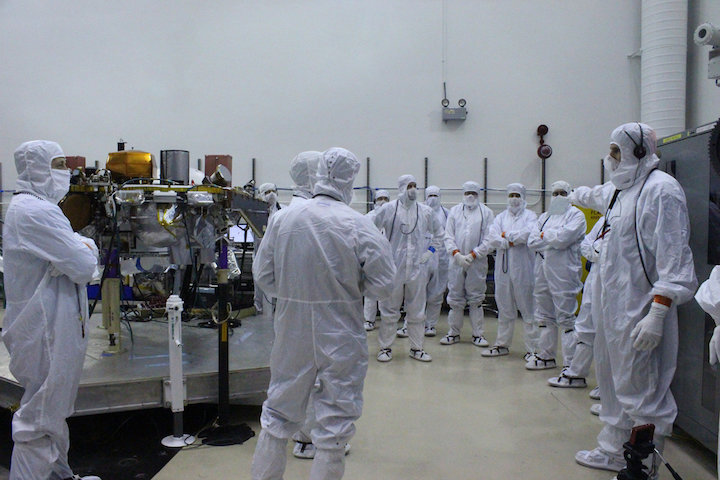
Technicians huddle near NASA's InSight Mars lander to give the go-ahead for testing of the craft's solar arrays.
-
LITTLETON, Colo. – NASA's next Mars lander is in the final phases of preparation before heading to California's Vandenberg Air Force Base, where it will become the first interplanetary mission ever to launch from that site.
The InSight Mars lander (the name is short for Interior Exploration using Seismic Investigations, Geodesy and Heat Transport) recently underwent its last checkouts here at Lockheed Martin Space Systems Co., which built the spacecraft for NASA. The spacecraft is scheduled to launch on May 5 on a United Launch Alliance Atlas V rocket, and arrive on Mars in late November.
Take a look with us at the final testing for the next robot to land on Mars.
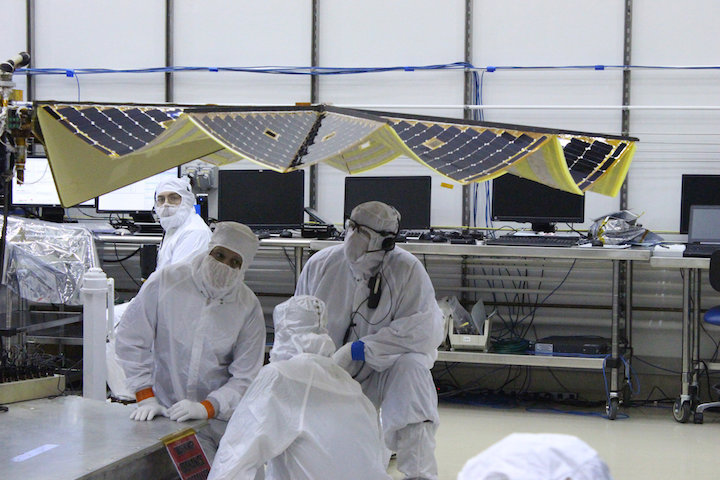
Credit: Barbara David
-
Loud pops for power
On Jan. 23, engineers unfurled InSight's solar arrays in a landmark test.
Technicians in clean-room garb carefully monitored the arrays as the arrays were fanned out in two large circles. The sequence started with loud pops as heaters on InSight warmed up the paraffin wax that releases the arrays. Then deployment motors kicked in, clicking and locking the arrays into place in a few minutes' time.
The test verified the exact process InSight will carry out on the surface of Mars after it lands. By using a tower of bright lights to illuminate the arrays, test engineers confirmed that the arrays were churning out power.
"This was our last major test before we start building up into a launch configuration," said Scott Daniels, manager of the assembly, test and launch operations (ATLO) phase for InSight at Lockheed Space. Following the test, the dual arrays will be re-stowed for the spacecraft's trip to Mars.
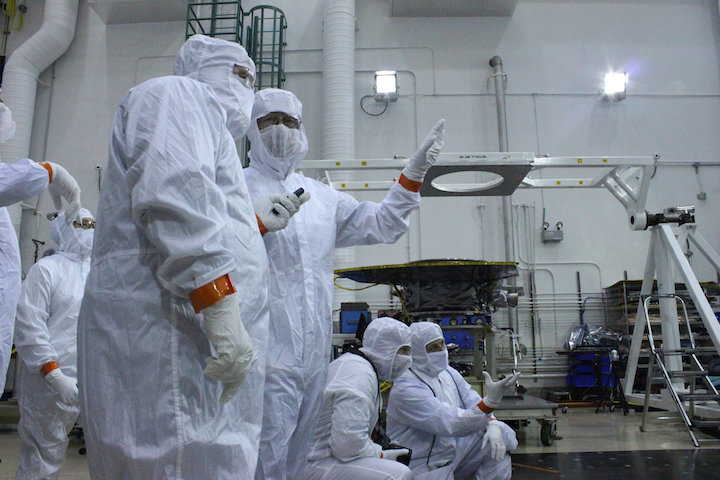
Space.com's Leonard David, on the floor with the Mars-bound InSight spacecraft, talks with Bruce Banerdt, InSight principal investigator.
-
A good, clean test
InSight passed its solar-array test with flying colors, Daniels said.
"This test worked really successfully. It was the cleanest run that we've done. We verified that we can draw power on the arrays, we verified telemetry, and everything looks nominal," he added. "Mechanical inspections looked really good and clean. Everything happened when it was supposed to happen." [The Best (and Worst) Mars Landings Ever]
The next phase for InSight involves attaching its three landing legs, a parachute cone, a backshell and other hardware.
"One month from now we're going to be all stacked up in the launch configuration and inside a shipping container headed out to California," Daniels said.
InSight's roughly 30-day launch window opens May 5, when the lander will be boosted into space atop an Atlas V 401 rocket. After a six-month journey through space, InSight will make a rocket-powered touchdown on Mars on Nov. 26. The landing zone is within a flat stretch of western Elysium Planitia, near the Martian equator.
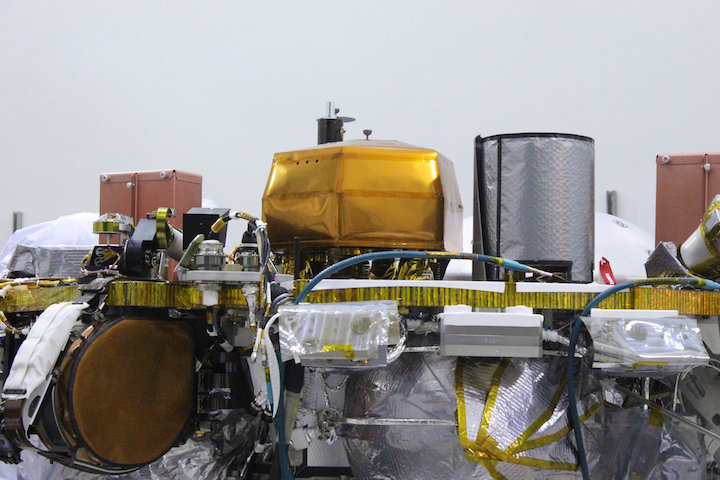
Second time around
The upcoming trip to Vandenberg will be InSight's second trek to California.
In December 2015, NASA called off InSight's original launch attempt planned for 2016. That no-go decision was sparked by unsuccessful attempts to repair a leak in the Seismic Experiment for Interior Structure (SEIS), a seismometer provided by France's Centre National d'Études Spatiales (CNES) – the French space agency.
SEIS is critical to InSight's on-the-planet duties. But during testing, the instrument failed to hold a vacuum.
Engineers with CNES and JPL combined their expertise to fix the SEIS woes.
Flawless testing
Today, InSight's SEIS instrument is working just fine. Just ask Bruce Banerdt, InSight mission principal investigator at NASA's Jet Propulsion Laboratory(JPL) in Pasadena, California. He was on hand at Lockheed Space for the recent solar array test.
"I'm ecstatic," Banerdt told Space.com. "Everything has been coming together really smoothly."
The testing of SEIS, the Heat Flow and Physical Properties Package (HP3), provided by the German Space Agency, as well as the Rotation and Interior Structure Experiment (RISE), led by JPL, have gone flawlessly, Banerdt said.
"The spacecraft has performed without a hitch. It has been like clockwork," Banerdt said. "I come out here and look at it every once in a while, just because it gives me goosebumps. But mostly I try to stay out of the way of the people who are actually doing the work of putting InSight together.
"I'm in awe of the job they've done," he said.
Quelle: SC
---
Update: 13.02.2018
.
Delicate solar panels of Martian lander are tested before launch
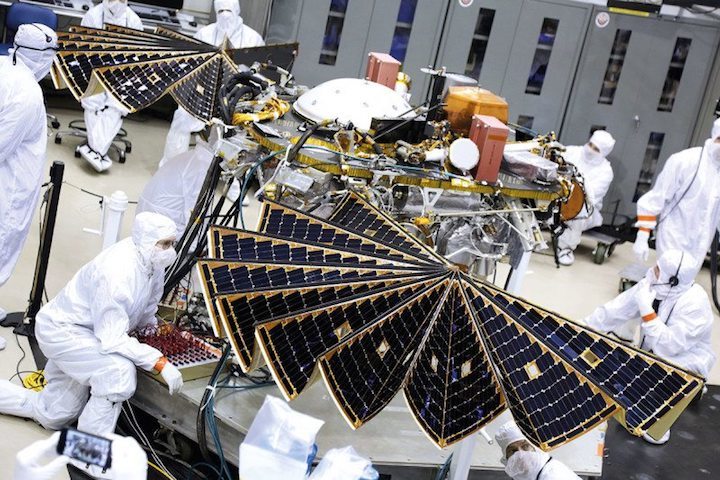
THESE intricate solar panels will help unlock the deepest secrets of Mars. They were opened in a test facility at Lockheed Martin’s Space division in Colorado as part of a check of NASA’s InSight lander. The craft is due to blast off on its journey to the surface of the Red Planet in May.
If it lands successfully six months later at Elysium Planitia, a plain straddling the Martian equator, there will be a 16-minute pause to let the dust settle before the photovoltaic arrays unfold like delicate Japanese fans. This design minimises mass and volume in flight, but will maximise the panels’ efficacy on Mars, where the sun’s intensity is a third of that on Earth. Both panels are about 2.2 metres in diameter and their solar cells are similar to those used on Earth, but specifically tuned for the limited light on Mars. In optimum conditions there, they will feed 600 to 700 watts of electricity to the craft’s batteries.
That store of energy will be vital to InSight’s two-year mission. Short for Interior Exploration using Seismic Investigations, Geodesy and Heat Transport, it is a static lab packed with instruments designed to probe the guts of Mars. Because the planet’s interior calmed more rapidly than that of Earth, its ancient internal structures are much better preserved, and will tell us a lot about how the core, mantle and crust of rocky planets form.
Quelle: NewScientist
---
Update: 15.02.2018
.
NASA is sending a piece of Mars back home
A million-years-old rock is flying home.
The ancient rock, named “Sayh al Uhaymir 008,” or “SaU008,” was once part of one of a meteorite that landed on Earth after blowing off from Mars millions of years ago.
SaU008 was discovered in Oman in 1999 and is the only one of 200 similar rocks that’s strong enough to withstand the journey back home, according to NASA.
“Every year, we provide hundreds of meteorite specimens to scientists all over the world to for study,” Caroline Smith, the principal curator of meteorites at London’s Natural History Museum – which provided the rock, said in the press release. “This is a first for us: sending one of our samples back home for the benefit of science.”
The meteorite piece will head back to Mars as part of NASA’s Mars 2020 rover mission. Once it arrives, SaU008 will be blown to bits in order to calibrate a high-precision laser named ‘SHERLOC’ that will be positioned on the rover’s robotic arm.
SHERLOC is being designed to examine rock and chemical features as fine as human hair and will need something to help it get its bearings on the alien planet. In the past, NASA has used rocks, metals and pieces of glass to help adjust similar technology to its new martian surroundings.
But this time around, NASA thought it might be more effective to use something that already has the same composition as the planet SHERLOC is being designed to explore.
“We’re studying thing on such a fine scale that slight misalignments, caused by changes in temperature or even the rover settling into sand, can require us to correct our aim,” Luther Beegle, NASA’s principal investigator, said. “By studying how the instrument sees a fixed target, we can understand how it will see a piece of the Martian surface.”
Once the laser is adjusted, it will photograph rocks on Mars and use a UV light to analyze and search for signs of life.
Quelle: New York Post
---
Update: 17.02.2018
.
NASA's Mars 2020 Rover Will Carry a Piece of Mars Back to the Red Planet
NASA's next generation Mars rover will use a Martian meteorite to calibrate its detectors.
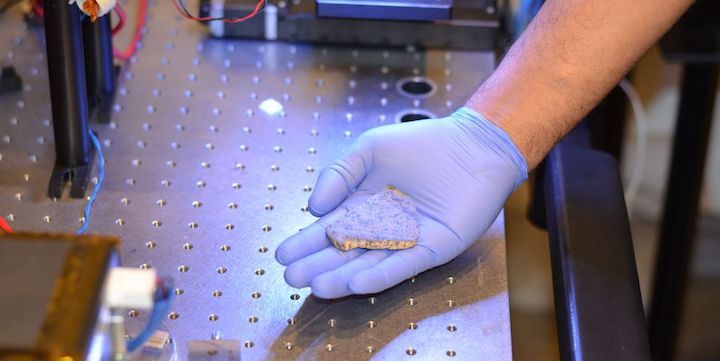
In two years, NASA will launch its most advanced Mars explorer yet: the Mars2020 rover, which will explore the Red Planet for signs of life. Aboard the rover will be dozens of high-tech instruments designed to measure everything about Mars, plus a piece of the planet itself: NASA is reporting that Mars2020 will carry a fragment of a meteorite that originally came from Mars.
The meteorite, Sayh al Uhaymir 008 (SaU008), was discovered in Oman in 2008, and was likely blasted off the surface of Mars millions of years ago. After drifting through space for who knows how long, it finally landed on Earth. These types of meteorites are extremely rare, with only about 200 confirmed by The Meteorological Society.
So why send one to Mars? In part, it’s a sentimental artifact, similar to the Voyager golden records. But it also serves an important piece of scientific equipment. As part of the Mars2020 mission, the rover will be analyzing the chemical makeup of Martian rocks, and the machines it uses needs to be calibrated.
In particular, Mars2020 comes equipped with a laser that can illuminate features smaller than a human hair in Martian rocks. This laser will allow the rover to identify different types of rocks and piece together events in the geologic history of Mars.
Such a device is incredibly sensitive, which means it requires frequent calibration. “We're studying things on such a fine scale that slight misalignments, caused by changes in temperature or even the rover settling into sand, can require us to correct our aim,” says Luther Beegle of JPL.
So, the rover needs an object that it can use to calibrate its devices, which is the role that SaU008 is going to fill. Previous Mars rovers have used rocks, glass, and metal for calibration, but the Mars2020 team wanted something different. They decided to bring along their own Mars rock to keep the laser working.
So when the Mars2020 rover touches down on the Martian surface in a few years, it will be the first to bring a piece of Mars back home. A tiny rock that has traveled millions of miles to get here will be sent back where it came from, and when it gets there it’ll help us learn even more about our tiny planetary neighbor.
Quelle: PM
---
Update: 23.02.2018
.
A brief history of Martian exploration – as the InSight Lander prepares to launch
Roughly every two years Mars and Earth wander a bit closer to each other, making the leap between these two planets a little easier. In July this year, Mars will only be about 58 million kilometres away – and NASA is set to take advantage by launching their next mission to the red planet in May 2018. The InSight Lander, will be the first Mars mission to investigate the planet’s “inner space”, and will listen for marsquakes to investigate the crust, mantle, and core.
InSight will join two rovers currently exploring the surface of Mars, and 14 spacecraft that are in orbit about it – albeit only six of which are currently sending us data.
Why does Mars, the red planet, have such a hold over us?
There are, after all, seven (or eight) other planets to explore – and yet we seem to have such a hang up on this one.
I guess it’s the tantalising nature of Mars. Here is a planet that we could conceivably walk on (unlike the gas giants), without being crushed by atmospheric pressure (like on Venus), having to deal with the radiation of being closer to the sun (Mercury) or just being far too far away (like Pluto). It calls to us through science fiction and fact, a planet that is so like our own Earth, but so unlike it at the same time.
The six current operational missions show that the fascination with Mars isn’t limited to one country, as European, Russian, American and Indian space agencies all have stakes in these crafts.
For comparison: our other nearest neighbour, Venus, only has one spacecraft currently in orbit about it, Akatsuki the spacecraft that wouldn’t quit. In fact, after the dramatic ending of the Cassini spacecraft, the only other planet currently being orbited by an Earth-built satellite is Jupiter, with the Juno mission.
Water on Mars
But, while our progress to walking on Mars has been very slow, our progress in understanding our neighbour has been really quite impressive. When I started my planetary science degree in 2001, the course did not include sedimentology, the branch of geology that investigates how water has shaped rocks. It was deemed there was no point as no water has been seen on any other planet.
By the time I was in third year, the first years students behind me were getting well versed in how water could push around sand, silt and clay on other planets.
Finding water on Mars had been an obsession to many, and thanks to data from Mars rovers Spirit, Opportunity and latterly Curiosity we know that it’s there – just trapped in the rocks. A couple of years ago it was thought that we had even found water flowing on the surface of Mars, but that evidence is (ahem) drying up now.
However, whether the water flows or is trapped in the rocks, the next question is where is the rest of it? If many of the rocks we see on Mars had been laid down by water - where is that water now?
The answer would be tangled up with the fate of Mars’s atmosphere. Though pitifully thin now, it must have been thick enough in the past to support flowing water on the surface. The mission of the spacecraft Maven (along with others) has been investigating this question - and all evidence is pointing to the Sun as the culprit for Mars’ missing atmosphere, with the solar wind gradually stripping it away.
Mars’ surface
It’s often touted that we know more about the surface of Mars than we do the bottom of our own oceans – and in terms of mapping resolution that’s true. Through the efforts of four orbiting missions we know how old most of the surface is, as well as how active it has been.
You can spend a joyful afternoon of procrastination flitting through HiRISE images that show sweeping dunes and pock-marked plains on Mars. With these images we can really apply our understanding of processes on Earth to what makes up the surface of Mars - from the formations of geological features, the movement of dust and sand and how the ice caps change through the seasons.
What’s inside Mars?
So we know there is water on Mars, we know where its atmosphere went and also the shifts of its sands – but there’s a missing piece of the puzzle. What’s on the inside?
To be fair, in this respect the interior of our own Earth is just as much of a mystery – but we have had centuries of seismic studies. From monitoring the passage of earthquakes through our planet we have built a picture of the layers that make up its interior. From that we’ve been able to undertake experiments that recreate the conditions and add more to that picture. At the moment we can only guess at the conditions within the interior of Mars – something that the InSight mission will answer.
After this, the next hurdle will be getting something back from Mars. We have a handful of meteorites that we know came from Mars, but having a sample that’s been collected and returned from a known location will priceless. NASA’s next rover, Mars 2020, will plan to do just this – but the return to Earth bit is still to be worked out.
From sample return to human exploration is still a massive step, and will require a number of innovations to get there. But with the knowledge we’ve built from the missions over the last decade, it’s becoming more of a reality.
Quelle: THE CONVERSATION
Update: 2.03.2018
.
NASA's InSight spacecraft has arrived at Vandenberg Air Force Base in central California to begin final preparations for a launch this May. The spacecraft was shipped from Lockheed Martin Space, Denver, today and arrived at Vandenberg at 3:49 p.m. PST (6:49 p.m. EST). The launch period for InSight opens May 5 and continues through June 8. InSight will be the first mission to look deep beneath the Martian surface, studying the planet's interior by listening for marsquakes and measuring the planet’s heat output. It will also be the first planetary spacecraft to launch from the West Coast.
"The Air Force C-17 crew from the 21st Airlift Squadron gave us a great ride," said Tom Hoffman, InSight project manager, from NASA's Jet Propulsion Laboratory in Pasadena, California. "Next time InSight travels as high and as fast, it will be about 23 seconds into its launch, on the way to Mars."
At the Astrotech payload processing facility at Vandenberg, InSight will soon be removed from its shipping container -- the first of several remaining milestones to prepare it for launch. Later next week, the spacecraft will begin functional testing to verify its state of health after the flight from Colorado. After that, the team will load updated flight software and perform a series of mission readiness tests. These tests involve the entire spacecraft flight system, the associated science instruments and the ground data system.
"One of the most important activities before launch is to load the spacecraft with the fuel needed for the journey to Mars," said Hoffman. "After fuel loading, the spacecraft will undergo a spin-balance test to determine precisely the center of mass. This knowledge is needed to be sure the entry and descent into the Mars atmosphere goes as planned."
InSight will be carried into space aboard a United Launch Alliance Atlas V-401 rocket lifting off from Space Launch Complex 3E at Vandenberg Air Force Base. For a May 5 liftoff, the launch window opens at 4:05 a.m. PDT (7:05 a.m. EDT) and remains open through 6:05 a.m. PDT (9:05 a.m. EDT).
InSight will use the seismic waves generated by marsquakes to map the deep interior of Mars. These waves travel through geologic materials at different speeds and reflect off boundaries, giving scientists a glimpse of the composition and structure of the planet's interior. They reflect the initial formation of the planet, and the resulting insights into how Mars formed will help us better understand how other rocky planets are created, including our own Earth.
JPL manages InSight for NASA's Science Mission Directorate. InSight is part of NASA's Discovery Program, managed by the agency's Marshall Space Flight Center in Huntsville, Alabama. The InSight spacecraft, including cruise stage and lander, was built and tested by Lockheed Martin Space in Denver. A number of European partners, including France's Centre National d'Études Spatiales (CNES) and the German Aerospace Center (DLR), are supporting the InSight mission.
Quelle: NASA
---
Update: 3.03.2018
.
InSight lander flown to California for final launch preps
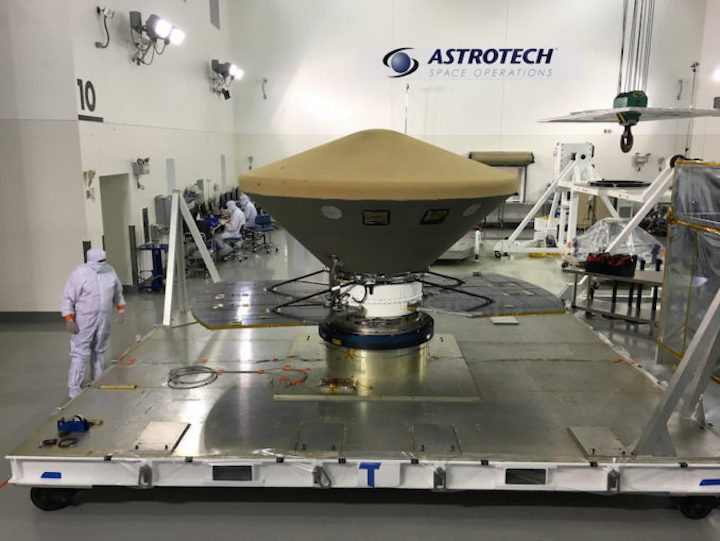
NASA’s robotic InSight Mars lander arrived at Vandenberg Air Force Base in California this week aboard a U.S. Air Force cargo plane, ready for final testing, fueling and launch aboard an Atlas 5 rocket May 5, two years later the originally planned.
Carried aboard an Air Force C-17 transport plane, the spacecraft touched down on Vandenberg’s runway Wednesday afternoon after a trip from Buckley Air Force Base, Colorado, near Lockheed Martin’s spacecraft manufacturing facility in Denver.
“The Air Force C-17 crew from the 21st Airlift Squadron gave us a great ride,” said Tom Hoffman, InSight project manager, from NASA’s Jet Propulsion Laboratory in Pasadena, California. “Next time InSight travels as high and as fast, it will be about 23 seconds into its launch, on the way to Mars.”
Teams transferred InSight, which took the trip inside an environmentally-controlled container, to an Astrotech clean room on the base, where engineers unpacked the lander from its shipping box Thursday to begin several weeks of checkouts and tests.
InSight’s launch window May 5 opens at 4:05 a.m. PDT (7:05 a.m. EDT; 1105 GMT) and extends for two hours. The mission has until June 8 to launch and reach Mars for an automated landing Nov. 26.
The mission will be the first planetary probe to launch from Vandenberg Air Force Base.
The spacecraft was supposed to launch in March 2016, but problems sealing a vacuum enclosure containing one of the lander’s primary instruments, a seismometer, forced officials to postpone the mission. Mars launch opportunities come once every 26 months, when the planets are in the proper positions in the solar system, so the next chance to send InSight to the red planet is in May.
The seismometer sensors are now healthy, their enclosure sealed, and are ready for launch. The InSight spacecraft itself, along with a German-built heat probe sensor and the United Launch Alliance Atlas 5 rocket, were all in position at Vandenberg for the March 2016 launch when NASA managers decided in December 2015 to keep the mission on the ground.
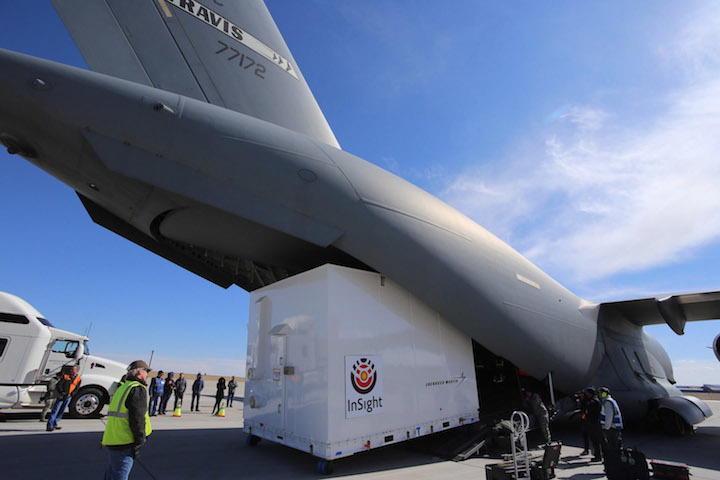
Officials flew the InSight spacecraft back to its Lockheed Martin factory after NASA’s decision, and placed the lander in storage until last year, when the redesigned seismometer package arrived from France. Technicians installed the seismometer on the lander, then put the craft through a series of thermal, vacuum and acoustic tests to ensure it will survive the journey to Mars.
“We really wrung out everything on the vehicle,” said Scott Daniels, Lockheed Martin’s assembly, test and launch operations manager for InSight. “This time around, we had all the flight components in, and we got a lot of good performance testing and environmental testing that gives us confidence that we’re ready to launch.”
InSight is already in its launch configuration, with the lander cocooned inside a heat shield and back shell that will protect it during the cruise to Mars, and then during entry into the Martian atmosphere.
Once ground crews place InSight on a rotation fixture in the clean room, they will begin testing the spacecraft to ensure it was undamaged during the trip from Colorado to California. Engineers will also upload a final version of InSight’s flight software program into the lander’s computer, Daniels said in an interview.
“Once we get it checked out, they’ll take the heat shield off of it again, which exposes the bottom of the spacecraft,” said Bruce Banerdt, InSight’s principal investigator at NASA’s Jet Propulsion Laboratory. “That will allow them to make the final connections that we need to make in order to run all the verification tests on the electronics to make sure everything is fine after shipment, and allow us access to fill the propellant tanks.”
Workers will load helium pressurant and hydrazine fuel into the spacecraft later this month, then engineers will ready InSight to meet its Atlas 5 booster, a process that includes encapsulating the probe inside the Atlas 5’s nose cone.
“We stay in the launch configuration,” Daniels said. “There’s really a limited number of things that we have access to and also a limited of number of things we’re really going test while we’re there. It’s pretty close to a ‘ship and shoot’ for a NASA mission.”
“We integrate with the payload adapter, do the final heat shield installation, close out, do the encapsulation, and drive out to the pad,” Daniels said.
The Atlas 5 rocket originally assigned to launch InSight, designated AV-062, instead launched with the WorldView 4 Earth-imaging satellite in November 2016. A different Atlas 5 vehicle, numbered AV-078, is currently at Vandenberg, where it could be stacked on the launch mount at Space Launch Complex 3-East as soon as this weekend.

Plans to transfer the Atlas 5’s first stage to the Vandenberg launch pad Friday were thwarted by heavy rainfall at the West Coast launch base.
Once the first stage is lifted vertical inside the launch pad’s mobile service gantry, ULA’s team will hoist a Centaur upper stage atop the rocket. After a series of rocket tests, InSight will join the Atlas 5 at the launch pad in mid-April.
InSight will launch on the lightest version of the Atlas 5 family — known as the “401” configuration — with no solid rocket boosters and a four-meter (13-foot) diameter payload fairing.
InSight could launch from Florida or California, but ULA and NASA agreed to launch InSight from Vandenberg to reduce the Atlas 5 team’s workload at Cape Canaveral, where up to a half-dozen flights are planned this year. InSight is the only Atlas 5 mission set for launch from Vandenberg in 2018.
Lockheed Martin built the InSight lander on the design of the Phoenix probe, which touched down on Mars in 2008. Phoenix launched from Cape Canaveral in 2007 on a smaller Delta 2 rocket, a launcher set for retirement later this year, and InSight’s mass at launch is well below the maximum interplanetary lift capability of even the lightest Atlas 5 configuration.
That means InSight does not require the extra boost of energy a rocket would obtain from the Earth’s rotation by launching to the east from Cape Canaveral. The Atlas 5 launching InSight will instead head south over the Pacific Ocean from Vandenberg, which is located around 140 miles (225 kilometers) northwest of Los Angeles.
Two CubeSats developed at JPL will accompany InSight on the launch. Once they arrive near Mars, the CubeSats will relay telemetry from InSight back to Earth as the probe descends through the Martian atmosphere.
But the experimental nano-probes are secondary to InSight’s mission, and the lander’s success will not depend on the CubeSats.
InSight will touch down at Elysium Planitia, a broad plain just north of the Martian equator, and use a robotic arm to place its seismic enclosure on the Martian surface to listen for quakes. The lander’s heat probe will burrow to a depth of around 16 feet, or 5 meters, to measure the amount of heat escaping the planet’s interior.
The seismometer instrument will be able to measure ground movements as small as half the radius of a hydrogen atom, NASA said, to sense minor shaking that may originate deep inside Mars. No mission has made a confirmed detection of “marsquakes” before, but instrumentation left behind by the Apollo astronauts discovered such tremors on the moon.
Scientists want to know about the structure of Mars’ interior, and they say InSight’s findings will help their understanding of how rocky planets, including Earth, formed in the early solar system.
NASA officials were uncomfortable launching InSight with a faulty seismometer instrument because the sensor package’s measurements are central to the mission’s overall objectives.
CNES, the French space agency, is responsible for providing the seismic instrument.
The InSight mission’s budget from NASA was originally $675 million, but the two-year delay will push the cost above $800 million. Those figures do not include funding from CNES and DLR, the German space agency, for InSight’s two main instruments.
The cost of the delay was primarily borne by NASA, but CNES was also on the hook for some of the instrument rework, officials said.
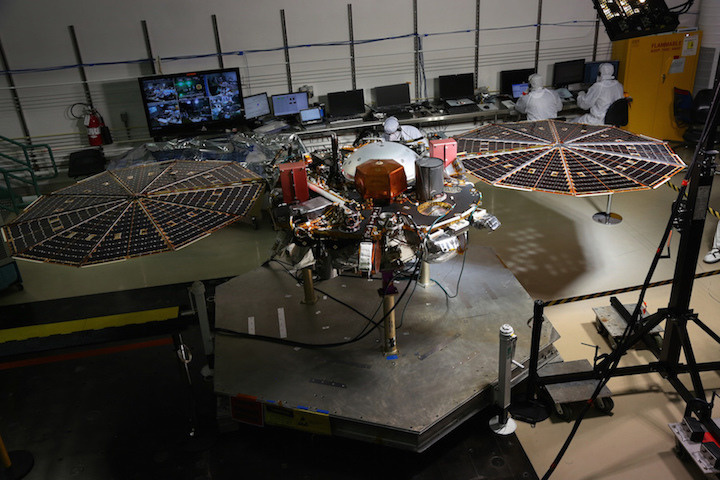
In an interview Thursday with Spaceflight Now, Banerdt said U.S. and French engineers jointly redesigned the thermal vacuum enclosure containing the seismic sensors.
“The basic structure of it is the same as it was before, but we looked at all the connections, all the welds, everything in the vacuum container that might possibly be a problem, beefed it up, made it more robust in just about every way that we could, and even put some materials on the inside that would absorb gases, mostly for gases that would come off things like adhesives — outgassing on the inside of the container — but also would be able to somewhat mitigate a small leak on Mars as well,” he said.
The enclosure passed a vacuum leak check last year before the seismometer team shipped the instrument to the United States from France.
“We went and tested the living bejesus out of it, in every way that we would,” Banerdt said. “And it passed all our tests with flying colors before we even put the seismometers inside one. We had a qualification model that was identical to what we were going to use for flight and tested it to much more extreme conditions than the flight model will ever see, and had absolutely no problems. We all believe that we’ve got a really, really solid vacuum enclosure for the seismometer.”
Scientists also used the two-year delay to upgrade the seismic package, and make the instrument more sensitive to quakes on Mars.
“We went back and did a little bit of work on the seismometer sensors themselves — the so-called VBBs, or Very Broadband Sensors — and beefed them up a little bit and tweaked their performance based on some of the testing that we did for the 2016 launch opportunity,” Banerdt said. “We were able to just change a few components in the electronics to get about a factor of two-and-a-half better performance out of the seismometers.
“We really did not want to slip this these two years, but I think we took really good advantage of the opportunity that we had in order to make the whole system more reliable and better performing,” he said.
Quelle: SN
---
Update: 14.03.2018
.
I FLEW WITH THE NEXT NASA SPACECRAFT THAT WILL LAND ON MARS
How to get a lander from Colorado to California
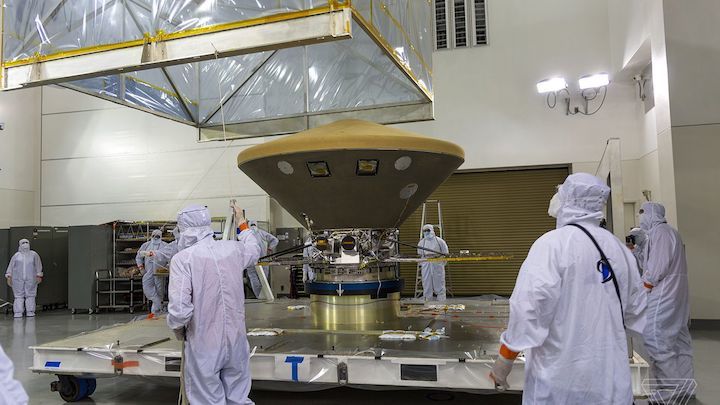
Inside a bright, cavernous room, a giant white metal box is rising toward the ceiling. A cable and pulley system tugs the box upward, and it ascends at just an inch a minute.
I’m staring at this box along with 30 or so other people, all of whom are wearing white. No, not wearing white — covered in white. Every person sports a white cloth onesie. No hands or shoes can be seen; all are shrouded in gloves and booties. Even hair doesn’t exist here. Every head is veiled in more white cloth. The only exposed skin I can see are the small slivers of flesh around each individual’s eyes. Mouths must be hidden, too.
I’m wearing the same odd outfit. I had to put it on before I was allowed in here — standard procedure when you enter a spacecraft clean room. And the clothing is extra important today since the box we’re all staring at isn’t just a box. It’s a shipping container. The clean room crew is lifting off the top of the container to reveal the box’s precious cargo: NASA’s next Mars lander.
The spacecraft is InSight, and if everything goes as planned, it will be out of this box and sitting on Mars by the end of the year. NASA plans to launch the vehicle in May; it will land in November. When InSight does take off, NASA wants very few Earth germs on the spacecraft. Our planet’s microbes are resilient; many can survive the harsh trip through space, and NASA doesn’t want to risk contaminating Mars with some big, bad Earth bug. That would make it difficult for future Mars missions to know if there is truly indigenous life on the Red Planet — or if we just put it there ourselves.
Hence, the funny outfits: we have to keep all our resident microbes on our skin and clothes to ourselves.
Unlike NASA’s Curiosity rover, InSight is a lander. That means it won’t be roaming around on the planet. It’s meant to stay in one spot on the surface, where it will measure Mars’ quakes. Yes, just like Earth, Mars might have quakes, though they’re different. Earthquakes are caused by shifts in tectonic plates on our planet, whereas “Marsquakes” are likely fueled by magma moving under the surface or the vibrations of cracks in the crust. InSight is designed to detect these quakes and use the wobbles to figure out what Mars is made of.
InSight will be the first interplanetary mission to ever take off from the West Coast. So far, every US mission to another planet or distant moon in our Solar System has launched from Florida. Rockets that fly to the east from Florida get an extra speed boost, but InSight is fairly small It doesn’t need the boost as much as heavier spacecraft do. And since Florida is a busy place for rockets launches, NASA plans to launch this vehicle on May 5th, from Vandenberg Air Force Base in Southern California, which is usually pretty open. That’s where we are now: a clean room on the base only a few miles from where InSight will launch. I’ve just spent the last day with Lockheed Martin — InSight’s manufacturer — and the US Air Force getting InSight over here.
How exactly does one move a spacecraft across the country, you might ask? Very carefully — and with a big plane.
Lockheed Martin built the majority of InSight at the company’s facility in Littleton, Colorado. Most of the manufacturing was completed three years ago. NASA originally hoped to launch InSight in May 2016, but one of the spacecraft’s instruments wasn’t working. In order to be sensitive to Marsquakes, InSight’s seismometer has to be sealed inside a vacuum chamber, and back in 2015, NASA found that this chamber was leaking. So the mission was pushed to 2018 — the next time when Earth and Mars line up on their orbits — to allow engineers time to fix the instrument.
So Lockheed Martin has actually moved InSight once before. The company transported the lander after a big snowstorm in mid-December 2015, before learning that the mission was delayed and that the spacecraft would need to go back to Colorado. Fortunately, the weather in Littleton is much nicer for our trip to Vandenberg. There’s barely a cloud in the sky, and it’s a nice 28 degrees Fahrenheit, which feels warmer than it does on the coasts. The air is super dry, and with the Sun shining, it all makes for a beautiful crisp day.
Our itinerary begins at Lockheed’s Littleton facility. From there, we’ll caravan in buses to Buckley Air Force Base. I’m traveling with a few members of the InSight team from Lockheed and NASA’s Jet Propulsion Laboratory, as well the crew tasked with handling the spacecraft. InSight, sealed tight in its white shipping box, will follow behind us, pulled by a semi truck. The container takes up a couple of lanes on the highway, so Lockheed has snagged a sheriff’s escort to drive in front of and behind the lander. Once we get to the base, the crew will load up the container on an enormous cargo plane provided by the Air Force, called a C-17. And when that’s done, we’ll head out to California with the spacecraft.
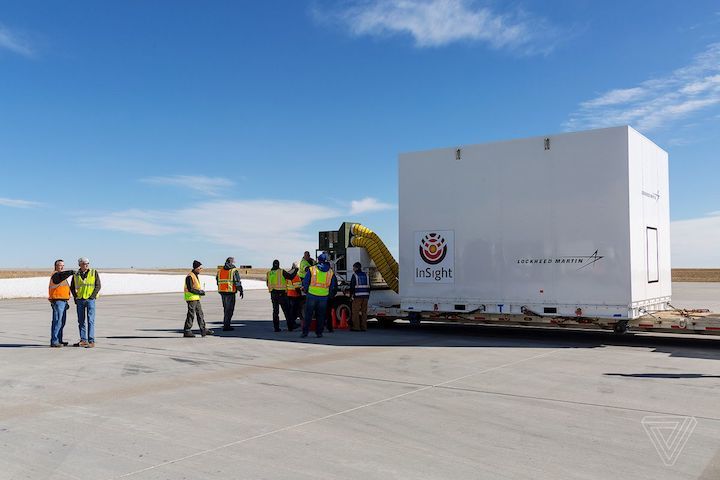
It’s going to be a long day since InSight can’t move very fast. Inside its box, the lander is surrounded by a large metal cage — referred to as the “birdcage” — that keeps it in place. But jostling in transit isn’t Lockheed’s biggest worry; the real struggle is keeping InSight at the right temperature and humidity level. If the temperature inside the shipping container gets too cold and the level of moisture gets too high, condensation might start to form on the spacecraft, like how dew forms on grass in the morning. But if water starts to form on InSight, the moisture could damage the vehicle and put the entire mission in jeopardy.
Lockheed is using an environmental control system to keep the temperature steady, so InSight’s shipping container has tubes sprouting from its back, attached to a heater and gas tanks. And if things start to get too moist inside the box, the company can purge the air with nitrogen gas. Nitrogen doesn’t hold moisture, so adding the gas to the box pushes out wetter air and keeps things dry. The only problem is that the tanks and heating system have to be disconnected in order to load InSight onto the plane.
“When we’re loading it on the plane, there’s not much we can do to keep the temperature warm,” Scott Daniels, the assembly, test, and launch operations manager of InSight for Lockheed, tells me. “So the temperature can start to go down in the spacecraft when we’re going on.” Daniels says he isn’t too worried since the weather is being cooperative today, and the crew will constantly monitor temperature during the load.
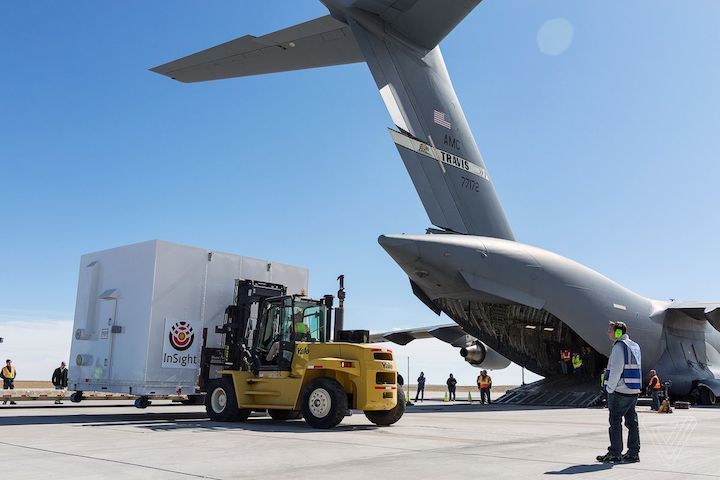
We all file into our buses at about 8AM and travel an hour to Buckley. Once there, Daniels gets a text that one of the panels sporting the InSight logo has fallen off the side of the container en route. Its velcro came loose — not a big deal, just a change of aesthetic. If it’s the only hiccup today, the team will be happy.
We step out of the buses, and in front of us is the C-17, a truly massive aircraft with four huge engines attached to its wings. We all mill around the tarmac for a bit, while a couple of F-16 fighter jets take off on the runway next to us. Eventually, InSight arrives, and it’s time to get this box on the plane.
It takes about five hours to lift the container off the truck with a forklift and then drag it into the cargo bay of the plane with cables. Every move has to be precise. The box inches forward toward the plane, and the move is frequently stopped so that someone can adjust the wheels of the container. When the box reaches the plane’s on-ramp at last, small metal inclines are placed in front of the wheels to help the box get over the hump of the ramp smoothly. Gary Napier, the representative for Lockheed who has been escorting me, tells me that those little inclines are made just for this operation. I silently wonder how much they cost.
Dozens of people handle the spacecraft, while the rest of the onlookers stand around the plane. One of them is William “Bruce” Banerdt, the principal investigator of the InSight mission. If the science of InSight were a movie, he’d be the director. I ask him how it feels watching his lander — a design that he has been working on for the last decade — get loaded into the belly of a C-17. “I feel nervous all the time,” he says, adding that “one little slip now, we just don’t have time to recover from it.”
Around 3PM, it’s finally time to fly. I walk up the staircase to the plane’s cargo bay. The interior looks just like the military planes do in the movies, though less polished. Tubes and machinery I don’t recognize line the walls. Everyone sits in metal chairs attached to the hull. There aren’t very many windows. A set of stairs is located at the front of the plane, leading to the cockpit. I ask a media relations officer if I can go up. She says I can ride in the cockpit for takeoff if I want. Um, of course I do.
I’m strapped into my seat, but I’m still thrown back against the chair when we zoom down the runway. It’s truly a stunning view, watching Colorado’s mountains grow smaller from the cockpit’s windows. I ask the pilot what it’s like to fly this plane. He says it takes him all over the world. Last week, he was in Africa dropping off military personnel. Tomorrow, he’ll be transporting another spacecraft to Florida — though its identity is a secret.
Two hours later, we touch down in California and step off the plane. A crowd of Air Force personnel, Lockheed employees, and NASA engineers are there to greet us. I’m asked if I want to stick around to see the crew unload InSight off the plane. I tell them I’ll just imagine the morning’s events in reverse. What I’m really looking forward to is the next day, when the crew takes InSight out of its box, and I can finally see the lander up close.
After spending the night in the nearby town of Lompoc (pronounced “Lom Poke,” as I’m frequently told), I head back to Vandenberg Air Force Base. Lockheed has a clean room facility on the base called Astrotech, where its spacecraft are processed before launch. That’s where InSight will stay for the next couple of months. Not only do I have to suit up to go inside, but I have to pass through a room that douses me in a clean air shower beforehand to blow off all the particles on me.
Once the top of the shipping container is removed, InSight is at last exposed in all its glory. Well, sort of glory: it’s upside down, bundled up underneath a big shield. That’s how it’s going to launch on the rocket: with its legs pointed up, or toward Mars. During the descent to the surface, the shield will protect the lander from heating up before InSight deploys its parachutes to slow its fall. Landing on Mars is notoriously difficult; the planet’s atmosphere is very thin, providing little cushion for incoming spacecraft.
Seeing the lander outside its box, I have an overwhelming urge to touch it. Would I be tackled? Can they arrest me? Plus, how would they decontaminate the Loren germs off of InSight? Perhaps they would launch anyway, and my microbes would make it all the way to Mars. I don’t touch the spacecraft.
After taking the necessary selfies with InSight, I’m forced to say goodbye to the spacecraft, but I know I’ll see this little lander again soon. I’ll be watching when it launches on that Atlas V in just a few months. It’s funny the extremes that this spacecraft gets to experience during its lifetime. For most of its time on Earth, InSight is treated so delicately, like a porcelain doll that is transported with utmost care. All in the service of strapping it onto a missile and shooting it into space at 10,000 miles per hour.
And if its landing goes well — or even if it doesn’t — then Insight will never travel anywhere else again.
Quelle: The Verge







